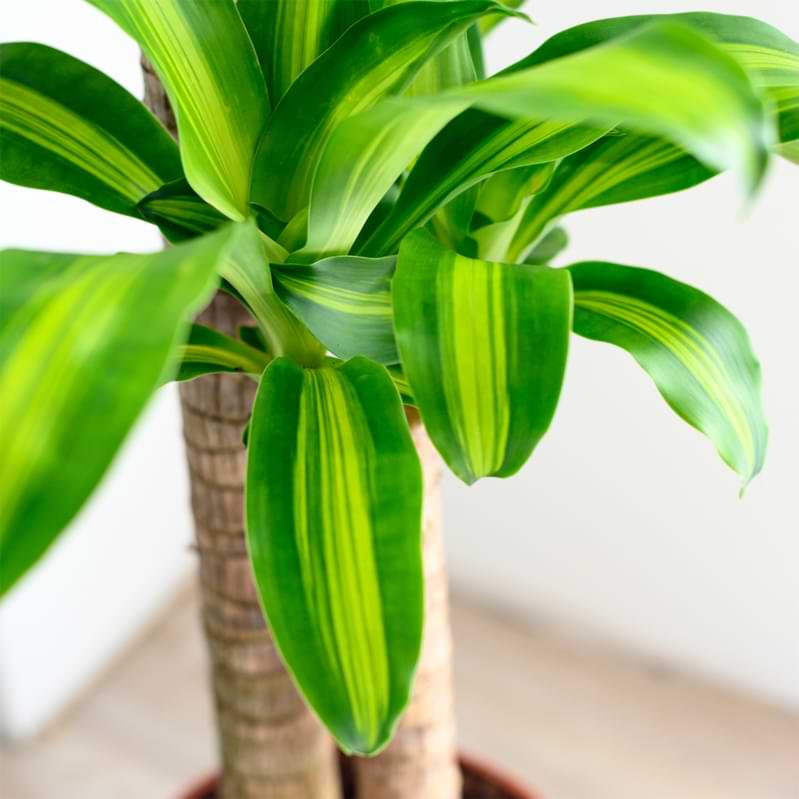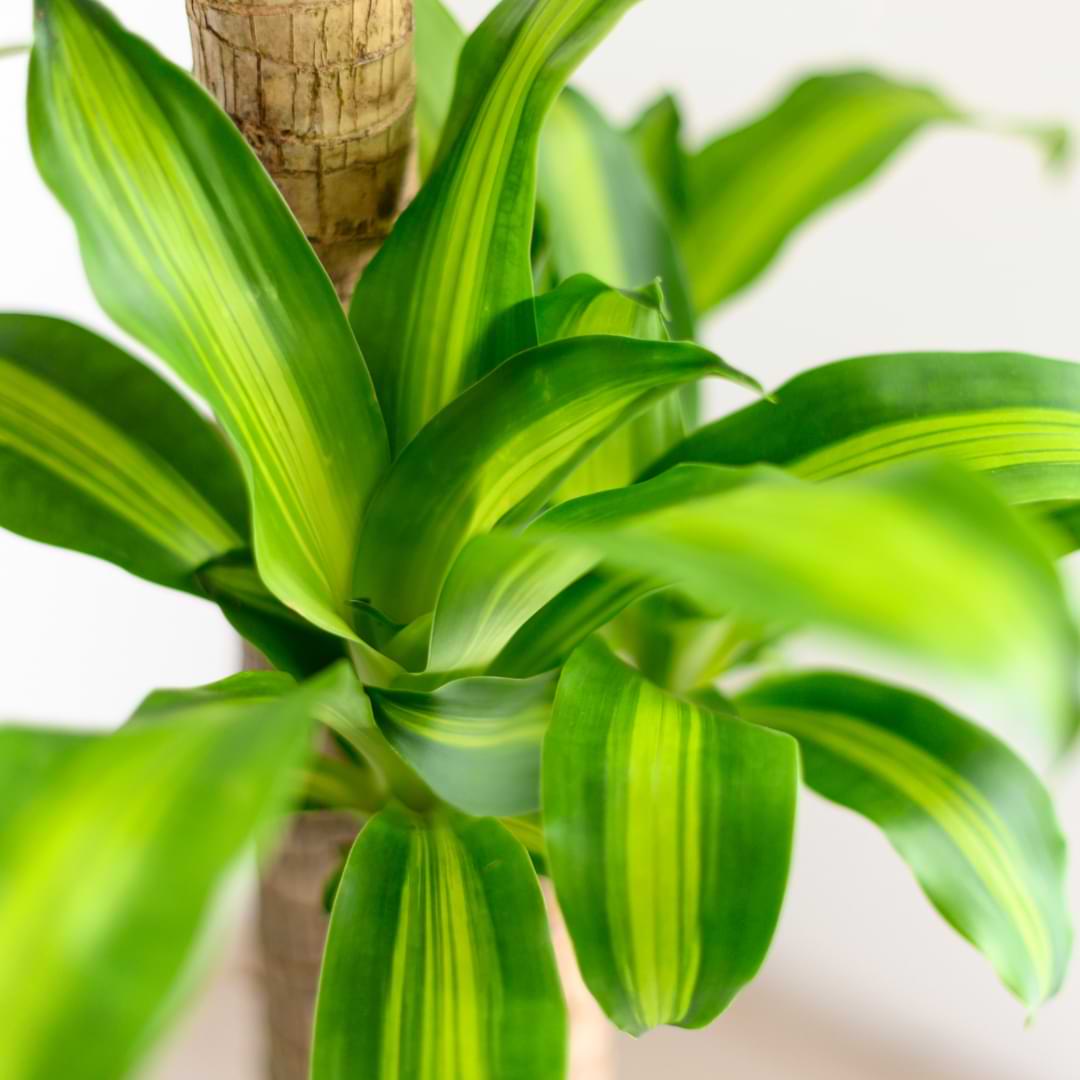Dracaena Cintho (also called Dracaena fragans cintho) is a beautiful dracaena variety known for its broad, strappy leaves with distinct emerald and lime-green coloring. It often comes in pots with two or three stems that resemble mini-palm trees. The best part is that Dracaena Cintho care is quite easy, as these plants are drought-hardy and don’t require much light to thrive.
This plant is the perfect choice if you want a touch of whimsical elegance in your space but don’t have a lot of windows and/or tend to forget to water your plants. You’ll get along well with a Dracaena Cintho!
Table of Contents
Introduction to Dracaena Cintho
Like all dracaenas, Dracaena Cintho is native to Africa.
A variant of Dracaena fragans, this plant is sometimes called the corn plant because its leaves somewhat resemble the leaves of a cornstalk in both appearance and texture.
These plants are typically pretty easy to find in gardening centers and online, so you shouldn’t have a problem locating one if you have your heart set on it.
NASA’s Clean Air Study has shown that dracaena plants are effective at removing toxins from the air, so this plant is an excellent option if you’re interested in using houseplants to purify the air in your indoor space.
Is Dracaena Cintho Toxic to Cats?
All dracaena species are toxic to cats, dogs, and other animals, so this may not be the best houseplant choice if you have pets who are prone to nibbling on plant leaves!
This plant isn’t considered toxic to humans, but it’s still not a good idea to ingest it. Keep this in mind if you have young children who might get curious about your plants and take a bite.
Dracaena Cintho Plant Care
Like most dracaenas, Dracaena Cintho is a beginner-friendly houseplant that doesn’t require a ton of upkeep or fussy conditions to be happy. If you’re just dipping your toes into the world of houseplants (or even if you’re a seasoned pro), you can’t go wrong with Dracaena Cintho!
Here’s how to care for this gorgeous and laid-back plant.
Height & Spread
Indoors, Dracaena Cintho will only grow to be about 3 feet tall with a spread of 1.5 feet or so (though it may be a little wider if you have more than one stem growing in the same pot). The leaves can reach up to a foot and a half long.
Overall, this is a pretty compact houseplant that’s much taller than it is wide, so it’s a great option if you want an indoor plant that makes an impact while taking up limited floor space.
Soil
Dracaenas need a light, fast-draining potting soil that will hold on to a little moisture but also dry out steadily.
Cactus soil can be a good choice, but you may want to mix in a few extra handfuls of perlite or vermiculite to keep commercial soils well-aerated.
Our Premium Potting Soil for Indoor Plants is also a great choice because it perfectly balances moisture retention and drainage while packing a nutritional punch to help your dracaena thrive.
A great, easy recipe for dracaena soil includes one part peat, one part vermiculite or perlite, and one part loam. This should keep the soil well-aerated and fast-draining while holding on to just enough water to keep your Dracaena Cintho happy.
Light
Dracaenas can tolerate and even thrive in fairly low light, so this is a good plant for those darker rooms in your space, or to put farther back in a room, away from the window. (This is great news for those of us who have tons of plants crowding our bright rooms and east-facing windows!)
This plant will grow faster and have more dramatic variegation in the bright, indirect sunlight that you’d find near an east-facing window, but it will do just fine in lower light.
Whatever you do, keep your Dracaena Cintho out of direct sunlight as this will quickly burn the leaves!
Temperature
Normal indoor room temperatures between 65 and 80 degrees Fahrenheit are ideal for Dracaena Cintho. If you’re comfortable, they’re comfortable!
That being said, make sure to avoid placing your plant near a drafty window or door, air-conditioning or heating vents, space heaters, or fireplaces. These blasts of cold or hot air can easily freeze or fry your plant, which can damage most of the leaves in a flash!
Humidity
Typical indoor humidity levels should be just fine for your Dracaena Cintho, but if you live in a very arid climate or use a lot of indoor climate control, you may notice the leaves drying out. If this becomes an issue (and you’ve eliminated other potential causes), your plant will probably appreciate occasional misting, a nearby humidifier, or being placed on a humidity tray.
Watering
Dracaena Cintho is fairly drought-resistant, so you should water when the top half of the soil feels dry to the touch, or when a moisture meter reads 2-3.
It’s also very important that you don’t use regular tap water on your Dracaena Cintho. All dracaena species are sensitive to chlorine, fluoride, and other chemicals present in most tap waters, and this will cause the leaf tips to brown in no time.
If you accidentally use tap water on your Dracaena Cintho and notice browning tips, try leaching the soil with purified water. Put the plant in a sink or tub and slowly add water and let it drain. You may need to do this a few times. Give the soil a chance to mostly dry out (this may take up to two weeks) and start watering with distilled or purified water when your plant is ready for a drink again.
Use distilled or purified water on your plant, or even rainwater if you can get it. If these aren’t options, you can also leave tap water out overnight or for at least 8 hours to give the chemicals a chance to dissipate.
This plant does NOT like sitting in wet soil for too long, so err on the side of underwatering rather than overwatering if you aren’t sure whether it’s time to water or not. Your plant may droop a bit if it’s thirsty, but it evolved to tolerate periods of drought; it won’t mind getting a little dried out sometimes!
Fertilizing
Dracaena Cintho grows fairly slowly (especially if you keep yours in lower lighting conditions), so it’s a pretty light feeder when it comes to fertilization. In the spring and summer, fertilize once a month or so with a diluted, gentle liquid fertilizer like Indoor Plant Food. You can skip fertilizing altogether during the fall and winter.
It’s far better to under-fertilize than overfertilize this plant, so err on the side of less fertilizer if you’re unsure, and make sure to carefully read the dilution instructions on the fertilizer label. Again, err on the light side here. It’s better to over-dilute a liquid fertilizer than make it too strong.
Repotting
Since this plant doesn’t grow quickly, you’ll probably only need to repot every other year or so, or when your plant appears to be root-wrapped. You’ll know your Dracaena Cintho is ready for a pot upgrade if you see the roots growing around in a circle inside the pot, and/or if you notice roots growing out of the top of the soil or out of the drainage holes in the bottom.
If the soil has compacted and hardened in the pot, it’s also a good idea to repot into fresh, fast-draining, well-aerated soil. When potting mix becomes compacted, it struggles to readily absorb water and drain that water once it does! Then you can run into symptoms of over- and underwatering. Not good!
Pruning
This plant doesn’t grow quickly or get too unruly with a lot of messy leaves or branches everywhere, so it’s unlikely you’ll need to prune your dracaena in order to control its shape.
If you get dried-out leaf tips, though, or otherwise damaged leaves, it’s a good idea to do some pruning to help the plant redirect its energy toward supporting healthy growth, and also to make the plant look better.
If a leaf is mostly damaged, it’s best to completely remove it. To remove a whole leaf, use sterilized scissors or shears to cut the leaf just above where it meets the stem or trunk. (You can wash your tools in soap and water, rubbing alcohol on a cotton ball, or clean with disinfectant.)
If your leaves have dry spots or crispy tips but are otherwise mostly okay, you can just remove the dead material and leave the rest of the leaf intact. To do this, make sure to cut inside the damaged material and avoid cutting into the healthy tissue. If you cut the healthy part of the leaf, that will just cause it to brown.

Dracaena Cintho Care FAQ
Here are answers to some of the burning questions you might have about Dracaena Cintho!
What grows well with Dracaena?
If you want to group your Dracaena Cintho or other dracaena with some other plant varieties, choose plants that thrive in similar lighting conditions and soil moisture levels.
You’ll need something that will be happy with bright, indirect light or even medium or lower lighting conditions (depending on where you’ve placed your dracaena) and that doesn’t require a lot of water. Drought-resistant plants are great!
Sweet potato vine, an ornamental similar to philodendron but that grows inedible tubers, is a common companion plant for dracaenas.
Impatiens flowers and petunias are also popular to grow with dracaenas and can add a little color to your arrangement.
A few well-chosen plant buddies for your dracaena will allow you to grow an eye-catching arrangement!
What other Dracaena varieties can I grow indoors?
There are lots of different dracaena varieties out there, ranging from the wide-leafed “corn plant” variations to the slim-leafed “dragon tree” varieties. There’s even a small species that resembles bamboo (and is, in fact, called “lucky bamboo”). These dracaenas are all easy to grow and wonderful for spaces with lower light conditions.
Check out our other articles on caring for dracaena plants:
The Ultimate Guide to Dracaena Marginata
The Ultimate Guide to Dracaena Varieties
Are dracaena plants susceptible to pests?
Not particularly, but it’s possible! When you water your plant, give it a once-over to check for potential problems, including dried-out tips, browning, or signs of insects such as tiny dots, webbing, sticky residue, or actual bugs.
If you notice insects, spray off your plant with a hose or kitchen sprayer to remove as many of the insects as possible (a lint roller on the leaves can also work well), and spray the plant with diluted neem oil, Leaf Armor, or even a gentle insecticide. You may need to do this a few times over a couple of weeks as new generations of pests hatch.
This isn’t a likely issue but it’s best to be prepared anyway!
Final Thoughts on Dracaena Cintho Care
Overall, dracaena plants are excellent choices for beginning houseplant parents, and Dracaena Cintho in particular is as beautiful and easygoing as they come!
Dracaena Cintho is also wonderful for habitual underwaterers.
Whether you have the ideal lighting conditions for most houseplants or not, try this plant to add a little tropical desert oasis flair to your space.
Give a Dracaena Cintho a try!
To learn more about Dracaena Cintho plant care and other houseplant resources, join our helpful community and sign up for our free webinar!
The Last Houseplant Book You Will Ever Need





